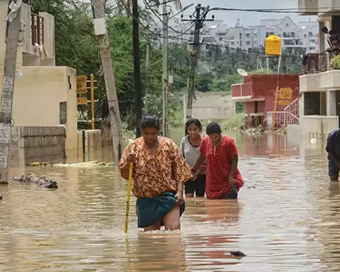Gallery
 PM Modi visit USA
PM Modi visit USA Only the mirror in my washroom and phone gallery see the crazy me : Sara Khan
Only the mirror in my washroom and phone gallery see the crazy me : Sara Khan Karnataka rain fury: Photos of flooded streets, uprooted trees
Karnataka rain fury: Photos of flooded streets, uprooted trees Cannes 2022: Deepika Padukone stuns at the French Riviera in Sabyasachi outfit
Cannes 2022: Deepika Padukone stuns at the French Riviera in Sabyasachi outfit Ranbir Kapoor And Alia Bhatt's Wedding Pics - Sealed With A Kiss
Ranbir Kapoor And Alia Bhatt's Wedding Pics - Sealed With A Kiss Oscars 2022: Every Academy Award Winner
Oscars 2022: Every Academy Award Winner Shane Warne (1969-2022): Australian cricket legend's life in pictures
Shane Warne (1969-2022): Australian cricket legend's life in pictures Photos: What Russia's invasion of Ukraine looks like on the ground
Photos: What Russia's invasion of Ukraine looks like on the ground Lata Mangeshkar (1929-2022): A pictorial tribute to the 'Nightingale of India'
Lata Mangeshkar (1929-2022): A pictorial tribute to the 'Nightingale of India' PM Modi unveils 216-feet tall Statue of Equality in Hyderabad (PHOTOS)
PM Modi unveils 216-feet tall Statue of Equality in Hyderabad (PHOTOS)The Badminton Association of India (BAI) has announced a 14-member-strong India squad for
- Men’s Sr Hockey Nationals to be played in division-based format from April 4
- Mensik denies Djokovic 100th title in Miami final
- KIPG: Son of a vegetable vendor, Bihar’s Jhandu Kumar eyes Worlds, 2028 Paralympics
- Hardik Singh credits hard work and team unity for receiving HI Midfielder of the Year award
- Djokovic, Alcaraz land in same half of Miami draw
Slippery runway, tailwind likely caused Kozhikode crash: Experts Last Updated : 08 Aug 2020 12:10:20 PM IST 
Kozhikode Plane Crash A deadly combination of a slippery runway, strong tailwind, bad weather conditions, and landing ahead of the threshold spot could have resulted in the skidding of the ill-fated Air India Express in Kozhikode that claimed 18 lives, two aviation experts said on Saturday.
An Air India Express aircraft flying in from Dubai skidded off the runway while landing in Kozhikode on Friday evening and plunged into the deep valley below. At least 18 people were killed, including two pilots.The aircraft carrying 190 persons, including six crew members, battled heavy rain while landing at 7.41 pm on Friday, and careered off the runway after landing at the table-top airport."It may be due to lack of friction between the tyres and the runway. There may be the factor of hydroplaning due to waterlogging," a pilot not wanting to be quoted told IANS.Hydroplaning is a condition in which presence of water causes a moving wheel to lose contact with the load-bearing surface, the runway in this case. This makes braking or manoeuvring of the vehicle (plane), impossible. Hence, the aircraft's speed could not be reduced after landing, the pilot said.Speaking to IANS, a former Indian Air Force (IAF) navigator pointed out that the standard 9,000-feet Kozhikode runway is not an issue for this kind of aircraft."Probably, the pilot landed ahead of the threshold or the usual spot, owing to bad visibility, strong tailwind, and a slippery runway -- all odds were stacked against him," the former navigator said."With a reduction in distance available to bring the plane to a halt, the pilot would have to literally sit on the brakes with full reverse engine power. The ditch at the end of the runway must have been on his mind. The slippery runway seems to have done the rest," he added.According to him, it was "bad luck" and perhaps "error of judgement" on part of the pilot that led to the tragedy.IANS Chennai For Latest Updates Please-
Join us on
Follow us on








172.31.16.186







